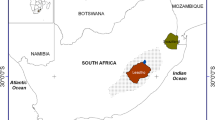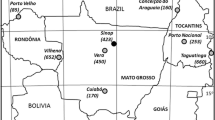Abstract
Mountain ecosystems have been projected to experience faster rates of warming than surrounding lowlands. These changes in climatic conditions could have significant impacts on high-altitude Andean environments, affecting the quality and magnitude of their economic and environmental services. Even though long-term data in these regions are limited, it is important to identify any discernible long-term trends in local climatic conditions. Time series of several variables were analyzed to detect statistically significant long-term linear trends that occurred over recent years in a páramo ecosystem of the Colombian Central Andes. Records included cloud characteristics, sunshine, rainfall, minimum and maximum temperatures, diurnal temperature range, and relative humidity. Conditions of atmospheric stability were also explored. Total sunshine exhibited decreasing trends ranging from −3.7 to −8.5% per decade at altitudes around the pluviometric optimum. The strongest changes in sunshine occurred during the December-January-February season. Mean relative humidity observed at altitudes around and below this threshold showed increasing trends of +0.6 to +0.7% per decade. Annual rainfall and mean relative humidity above the optimum showed decreasing trends ranging from −7 to −11% per decade and from −1.5 to −3.6% per decade, respectively. Minimum temperatures on the coldest days and maximum temperatures on the warmest days exhibited increasing trends at all altitudes ranging from +0.1 to +0.6, and from +0.2 to +1.1°C per decade, respectively. Increases in minimum and maximum temperatures at higher altitudes were significantly greater than those observed in average at lower altitudes. The strongest changes in minimum temperatures, particularly, occurred during the December–January–February and June–July–August dry seasons. All these changes suggest that atmospheric conditions in the area are shifting from statically unstable conditions to conditionally unstable or statically stable conditions. Observed historical trends indicate that climate impacts and other human activities have stressed these unique and fragile environments.




Similar content being viewed by others
References
Bradley RS, Vuille M, Diaz HF, Vergara W (2006) Threats to water supplies in the Tropical Andes. Science 312:1755–1756
Buytaert W, Célleri R, De Bièvre B, Cisneros F, Wyseure G, Deckers J, Hofstede R (2006) Human impact on the hydrology of the Andean páramos. Earth-Sci Rev 79:53–72
Castaño C (2002) Páramos y ecosistemas alto andinos de Colombia en condición Hotspot y Global Climatic Tensor. Instituto de Hidrología, Meteorología y Estudios Ambientales (IDEAM), Bogotá
Departamento de Geografía-Universidad Nacional de Colombia (2005) Escenarios de cambio climático para el territorio colombiano. Fase PDF-B, Integrated National Adaptation Pilot (INAP) - Informe Ejecutivo. Bogotá, Colombia, 19 pp
Diaz HF, Grosjean M, Graumlich L (2003) Climate variability and change in high elevation regions: past, present and future. In: Diaz HF (ed) Climate variability and change in high elevation regions: past, present and future—Advances in Global Change Research, Klumer Academic Publishers, 282pp
Foster P (2001) The potential negative impacts of global climate change on tropical montane cloud forests. Earth-Sci Rev 55:73–106
Gutiérrez H (2002) Aproximación a un modelo para la evaluación de la vulnerabilidad de las coberturas vegetales de Colombia ante un posible cambio climático utilizando Sistemas de Información Geográfica con énfasis en la vulnerabilidad de las coberturas nival y de páramo de Colombia. In: Castaño C (ed.) Páramos y ecosistemas alto andinos de Colombia en condición Hotspot y Global Climatic Tensor. Instituto de Hidrología, Meteorología y Estudios Ambientales (IDEAM), Bogotá, pp 335–377
Gutiérrez ME, Zapata PA, Ruiz D (2006) Understanding the signals of climate change and climate variability on the water supply of high mountain watersheds (in Spanish). Environmental Engineering Program, School of Engineering, Antioquia, Colombia, 160 pp
Hastenrath S (1991) Climate dynamics of the tropics. Kluwer, Dordrecht
Kendall MG (1975) Rank correlation methods. Charles Griffin, London
Meehl GA, Stocker TF, Collins WD, Friedlingstein P, Gaye AT, Gregory JM, Kitoh A, Knutti R, Murphy JM, Noda A, Raper SCB, Watterson IG, Weaver AJ, Zhao Z-C (2007) Global Climate Projections. In: Climate Change 2007: The Physical Science Basis. Contribution of Working Group I to the Fourth Assessment Report of the Intergovernmental Panel on Climate Change [Solomon S, Qin D, Manning M, Chen Z, Marquis M, Averyt KB, Tignor M, Miller HL (eds)]. Cambridge University Press, Cambridge, United Kingdom and New York, NY, USA, pp 764–765
Oster R (1979) Precipitation in Colombia (in Spanish). Revista Colombia Geográfica, 6
Pabón JD (2003) El cambio climático global y su manifestación en Colombia. Cuadernos de Geografia XII(1–2):111–119
Pabón JD (2004) El cambio climático y sus manifestaciones en Colombia. Innovación y Ciencia XI(3–4):68–73
Rossow WB, Walker AW, Beuschel DE, Roiter MD (1996) International Satellite Cloud Climatology Project (ISCCP) - Documentation of New Cloud Datasets. WMO/TD-No. 737, World Meteorological Organization, p115
Ruiz D (2009) Signals of climate variability/change in surface water supply of high-mountain watersheds. Case study: Claro River high mountain basin, Los Nevados Natural Park, Andean Central Mountain Range. World Bank Group’s Project 7147577. School of Engineering, Medellin, Colombia, p120
Ruiz D (2010) Indo-Pacific and Tropical Atlantic EOF modes: contributions to the analyses of cloud cover conditions in the Los Nevados Natural Park, Colombian Central Mountain Range. Revista Escuela de Ingeniería de Antioquia (EIA), ISSN 1794–1237, No. 14: 39–52
Ruiz D, Moreno HA, Gutiérrez ME, Zapata PA (2008) Changing climate and endangered high mountain ecosystems in Colombia. Science of the Total Environment. doi:10.1016/j.scitotenv.2008.02.038
Sen PK (1968) On a class of aligned rank order tests in two-way layouts. Ann Math Stat 39:1115–1124
The World Bank Group (2006) Colombia-Integrated National Adaptation Program Project - Documents & Reports (http://www.worldbank.org/).
The World Bank Group (2008) Assessing the potential consequences of climate destabilization in Latin America. Latin America and Caribbean Region Sustainable Development Working Paper 32 [W. Vergara (ed.)], 115 pp
Trenberth KE, Jones PD, Ambenje P, Bojariu R, Easterling D, Klein Tank A, Parker D, Rahimzadeh F, Renwick JA, Rusticucci M, Soden B, Zhai P (2007) Observations: Surface and Atmospheric Climate Change. In: Climate Change 2007: The Physical Science Basis. Contribution of Working Group I to the Fourth Assessment Report of the Intergovernmental Panel on Climate Change [Solomon S, Qin D, Manning M, Chen Z, Marquis M, Averyt KB, Tignor M, Miller HL (eds)]. Cambridge University Press, Cambridge, United Kingdom and New York, NY, USA, pp 265–271
Vernekar AD, Kirtman BP, Fennessy MJ (2003) Low-level jets and their effects on the South American summer climate as simulated by the NCEP Eta Model. J Clim 16(2):297–311
Vuille M, Bradley RS, Werner M, Keimig F (2003) 20th century climate change in the Tropical Andes: observations and model results. In: Diaz HF (ed) Climate variability and change in high elevation regions: past, present and future–Advances in Global Change Research, Klumer Academic Publishers, 282pp
Acknowledgements
The authors wish to thank A. Del Genio, D. Rind and A. Lacis (NASA Goddard Institute for Space Studies at Columbia University in the City of New York), M. Cane (Lamont-Doherty Earth Observatory, Columbia University in the City of New York), A. Jaramillo (Centro Nacional de Investigaciones de Café - CENICAFE) and C. Tobón (Departamento de Ciencias Forestales, Universidad Nacional de Colombia Sede Medellín) for their valuable comments. The research group thank the Colombian Institute of Hydrology, Meteorology and Environmental Studies - IDEAM, the Central Hidroeléctrica de Caldas - CHEC, the Centro Nacional de Investigaciones de Café - CENICAFE, the Corporación Autónoma Regional de Caldas - CORPOCALDAS, the Corporación Autónoma Regional de Risaralda - CARDER, the Instituto Geográfico Agustín Codazzi - IGAC, and the Unidad Administrativa Especial del Sistema de Parques Nacionales Naturales de Colombia - UAESPNN for providing data and continuous support. The group also acknowledges the following individuals for their assistance during field campaigns: the rangers of the Los Nevados Natural Park (special thanks go to M. H. Arias and J. B. de la Cruz), the guides of the Asociación Caldense de Guías (special thanks go to A. Mayorga), L. F. Giraldo (Eco-Turismo Estratégico) and A. Tibaguy, and all the employees of the Tourist Services of the Los Nevados Natural Park (Concesión Nevados). We also acknowledge the helpful suggestions made by three anonymous peer-reviewers who read and commented this manuscript. Research activities were supported by the World Bank Group (Contract 7147577: Signals of climate variability/change in surface water supply of high-mountain watersheds. Case study: Claro River high mountain basin, Los Nevados Natural Park, Andean Central Mountain Range) and the Programa en Ingeniería Ambiental, Escuela de Ingeniería de Antioquia (Colombia). DRuiz was partially supported by the Department of Earth and Environmental Sciences (Columbia University in the City of New York) and the International Research Institute for Climate and Society, Lamont–Doherty Earth Observatory.
Author information
Authors and Affiliations
Corresponding author
Additional information
The views reflected in this article are those of the authors and do not necessarily reflect views of the World Bank Group.
Electronic supplementary materials
Below is the link to the electronic supplementary material.
ESM1
(DOC 274 kb)
Rights and permissions
About this article
Cite this article
Ruiz, D., Martinson, D.G. & Vergara, W. Trends, stability and stress in the Colombian Central Andes. Climatic Change 112, 717–732 (2012). https://doi.org/10.1007/s10584-011-0228-0
Received:
Accepted:
Published:
Issue Date:
DOI: https://doi.org/10.1007/s10584-011-0228-0




